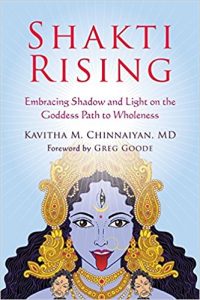The Cosmic Grin
 The Cosmic Grin
The Cosmic Grin
The circumstance was familiar. I sat at the altar, eyes closed, asking for guidance. Show me the way, I implored. You see, I was writing a book. A book about Shakti, the divine feminine. And I had no idea where this impulse to write a book came from. And of all things, about Shakti. I’m a cardiologist, after all. I have a lot of experience writing about heart disease. Amidst my already busy life, this irresistible urge to write about Shakti had risen unexpectedly and I didn’t know what to do about it.
I had had no plans to write books, even when I was voraciously updating my blog with posts now and then, purely out of the need to express what I was experiencing in my own spiritual practice. Whether anyone read those posts or not didn’t matter. In fact, for years, I didn’t even collect website statistics or email addresses. Writing arose as an upsurge of energy, craving to be expressed in some way. I’m not a dancer or an artist; writing is my creative outlet, and so there it was.
Writing Shakti’s Way
When the thought first arose about writing a book, it was more of the same creative urge rising so strongly that it couldn’t be ignored. Yet, the thought of a book was daunting. I didn’t (and don’t) have a big following, or an email list. I’m not really well-known, particularly in the area this creative urge was rearing its head in. Who would even read a book by an unknown author? Who would even publish such a book?
So, I turned to the only entity that could help—Shakti herself. For years, it has been my practice to turn over my problems to her and let her deal with them. Why bother with things when it’s her job? Whether it is a parking space, traffic woes, my children’s worries or a diagnosis when facing a patient, I’ve learned to not stress over things and to turn them over to her. Not that this is always easy or perfect—my brain still tries to butt in situations, pretends to know all the answers, and feel like it has control over everything that is occurring at any given moment. Being proven wrong about a thousand times hasn’t erased its capacity to feel all these things. In fact, turning to Shakti didn’t occur as the first step.
As any self-respecting writer must do, I started with Google, searching for “how to write a book.” Soon, I was deep into articles, blog posts and emails (that I didn’t remember signing up for) on how to write a book. Most of them suggested building an audience first. Many suggested that it is nearly impossible for a first-time author to land a deal with a publisher. I learned that you need a bazillion emails in your list and people in your circles ready to buy your books in bulk to make bestseller lists. Curiously, I started getting emails about “Masterminds;” an expert in the area could coach me in writing a bestseller—in exchange for a few thousand dollars. I giggled, wondering how anyone could possibly coach me in writing about the Mahavidyas. And giggled more at the thought of people buying such a book in bulk. It wasn’t going to help anyone lose weight or cure an illness; who’d be interested in a book that was about losing the ego?
To clarify, the Mahavidyas are ten specific forms of the divine feminine that represent cosmic forces like time and space. They are peculiar in that they defy the norms of what a goddess must look like, taking on fierce forms. Kali is the most famous of them, representing time and all the limitations that come with it.
For many years, my spiritual practice had revolved around these ten goddesses and now they wanted me to write a book about them. Easier said than done, particularly if I went about it the conventional, expert-assessed way.
The Mastermind That Matters
Sufficiently intimidated by what I read on the internet (and even some self-help books on writing), I decided that a book was not for me. I had neither the time nor the resources to build an audience that big, nor the interest to participate in Mastermind programs.
However, my decisions were irrelevant, since the urge to write came up stronger than before. It wasn’t a choice—I had to write. The creative energy built up, pulsing through my cells and flowing into words on paper. That’s when I turned to her.
Confused about what I thought were mixed messages, I found myself at the altar asking Shakti to show me the way. “Give me a sign, Ma,” I asked. I saw her in my mind’s eye, the beautiful, radiant goddess with the serene face and gentle smile. Suddenly, she grinned, her face contorted in great humor. Taken aback, I opened my eyes to see her image at the altar intact. No grin there. I closed my eyes again, deeply at rest in her peaceful, resplendent presence. And there it was again. The grin. Like she couldn’t control herself. “What’s up with that, Ma?” I thought.
She didn’t say anything, but the grin was telling. In a flash, I realized that I was being totally silly to take it all so seriously and to own all this writing stuff. She was cracking up at my ownership of the process. It was like she was saying, “Oh, for heavens’ sake! Why do you bother with who will read it and what will come of it? Do you really think it’s you that writes?”
Humbled, I emerged from my meditation a tad wiser—Ma’s message, like a famous brand’s tag line, was simple—just do it. So, I did, allowing the creative energy to flow through in writing. In a flash of inspiration, I shyly reached out to a friend in the publishing business and she expertly helped move things along. Within weeks, a contract materialized, much to my astonishment (even more miraculously, a second contract arrived a week later for another book from another company, this time via a literary agent I’d met through another friend). Importantly, both of these women have become my dear friends.
Writing and Letting Go
Contracts settled, I went back to writing, and found that I was struggling to find my writing voice. I’m an academic physician, with a formal writing voice that spews out facts and figures and draws logical conclusions. Here, none of that would do. Time and again, I found myself at the altar, asking Ma to show me the way. She always does. Whenever I was stuck, I’d see her grin in my mind’s eye, and almost immediately, a solution would arise. The most amazing editors materialized and came to my rescue, gently urging me to find a writing voice that was casual and warm. They gently coaxed me to allow the message to flow through in a voice that was authentically mine.
Whether it was finding the right voice or the right book title, I began to rely on what I came to call the cosmic grin—Ma’s barely-controlled humor that would be accompanied by the universe coming to help with the book. Her book.
And so, the book took shape in a way I’d never imagined. I’d wake up some Saturdays at 4 AM and start writing. When I’d look up, it would be 4 pm. Later, I’d go back and read what I’d written, and be astonished. Did I really write that? How did I know that? Immediately, I’d see the cosmic grin again in my mind’s eye. A few times, a wink accompanied the grin.
Her book, her writing.
Now that the book is published, I am back at her feet. “You know I’m clueless about publicity or marketing, Ma,” I say. She grins again. “Why do you worry, child? Whoever needs to know about me will find the book. It’s not your problem,” she says.
And so, I learn to surrender, knowing deeply that the only thing I can do as a writer is write. What comes of it is not my problem. In fact, once the urge to write arises, taking myself to be a writer is a lost cause.
It’s better to join in the cosmic grin. And lighten up.
—
Kavitha Chinnaiyan, MD, is an integrative cardiologist, meditation teacher and tantrika. She became drawn to the Direct Path through the teachings of Greg Goode and Sri Atmananda Krishna Menon, and has studied yoga, Sri Vidya Sadhana, Vedanta and Tantra through the teachings of Chinmaya Mission, Sri Premananda, Sally Kempton, and Paul Muller-Ortega. She blends her expertise in cardiology with her knowledge of Ayurveda, yoga, Vedanta, Tantra, and the Direct Path in her approach to healing, enabling patients to discover bliss amid chronic illness. She is an Associate Professor of Medicine at Oakland University William Beaumont School of Medicine in Rochester, MI.
About Shakti Rising: Embracing Shadow and Light on the Goddess Path to Wholeness
 The wisdom of the Mahavidyas, the ten wisdom goddesses who represent the interconnected darkness and light within all of us, has been steeped in esoteric and mystical descriptions that made them seem irrelevant to ordinary life. But with this book, written by a respected cardiologist who found herself on a spiritual search for the highest truth, you’re invited to explore this ancient knowledge and learn how it can be applied to daily struggles and triumphs—and how it can help you find unreserved self-love and acceptance.
The wisdom of the Mahavidyas, the ten wisdom goddesses who represent the interconnected darkness and light within all of us, has been steeped in esoteric and mystical descriptions that made them seem irrelevant to ordinary life. But with this book, written by a respected cardiologist who found herself on a spiritual search for the highest truth, you’re invited to explore this ancient knowledge and learn how it can be applied to daily struggles and triumphs—and how it can help you find unreserved self-love and acceptance.
The pursuit of contentment is an innate part of the human experience, arising from a fundamental sense of lack or inadequacy—all the things we believe to be wrong with us when we compare or judge ourselves. In our search for peace and happiness, we may find ourselves fighting the shadows within us, trying to repress or disown certain qualities, especially our anger, violence, discomfort, craving, and disappointment. But in order to stop this fight, we must expand our understanding beyond the dualities of good versus bad, right versus wrong, and beautiful versus ugly, and accept the parts of ourselves we’ve tried to deny.
Pulling from Eastern traditions including tantra and yoga, and focusing on the feminine principle of divine energy also known as Shakti, this book bridges the divide between dualistic concepts and non-dual philosophy. By exploring the symbolism of the Mahavidyas (Kali, Tara, Tripurasundari, Bhuvaneshwari, Tripura Bhairavi, Chinnamasta, Dhumavati, Baglamukhi, Matangi, and Kamalatmika)—each with a veiled face representing a destructive quality that perpetuates ignorance and suffering, and a true face representing the wisdom that stimulates profound transformation and liberation—you’ll learn to embrace and incorporate every aspect of who you are.
With practices, self-inquiry prompts, and stories from the author’s own spiritual seeking, this exploration of the divine feminine will gently reveal the source of your fear, pain, and suffering, showing you that when you allow those parts of yourself to arise and simply be, you can finally begin to heal, overcome your limitations, and open to the light and beauty of your true nature.
Category: Contemporary Women Writers, On Writing























